There’s a lot of pressure that comes with being the first overall pick, a reality that certainly isn’t lost on Dansby Swanson.
After being selected first in the 2015 draft by the Arizona Diamondbacks, Swanson, a Georgia native, was traded to his boyhood favorite Atlanta Braves a mere six months later.
Things worked out well at first. Swanson made mincemeat of the minors and acquitted himself well during his MLB debut with the Braves in late 2016, slashing .302 / .361 / .442 in 145 plate appearances. Just 22 years old and playing in front of his family and friends, things couldn’t be going much better for Swanson.
Unfortunately, the next two years were a disappointment. Mired by inconsistency and injuries, Swanson struggled mightily at the plate, evidenced by a combined 72 wRC+ between 2017 and 2018. With fellow draft classmates such as Alex Bregman and Andrew Benintendi already playing like perennial all-stars, the hype surrounding Swanson faded into a faint murmur.
But the darkest hour often lies just before the dawn. As morbid as things looked for Swanson at times last season, he has shown incredible rates of progression in 2019, with improved swing decisions, contact rates, and batted ball authority. As a result, Swanson is on pace for a 30 home run, 15 steal season to go along with xStats that point to even more production in the near future.
Better Swing Decisions
The first step in improving as a hitter is to make better swing decisions, which is also known as exercising improved plate discipline. From there, improved contact rates and exit velocities will often follow.
A good method to test a hitter’s plate discipline is to compare their swing percentages on pitches inside and outside the strike zone. The greater the difference between zone and outside swing percentage, the better a hitter’s swing decisions.
Swanson’s swing decision making in 2017 was decent, mainly built on a conservative approach against pitches outside the zone. However, he could have been more aggressive in the strike zone, with his zone swing rate hovering in the mid to high 60% range for much of the season.
2018 is when the wheels came off. By mid-season, Swanson was swinging at over 40% pitches outside the strike zone, an unsustainable level for most hitters. While he did increase his swings at pitches in the zone, a positive development, the relative increase was overwhelmed by his inclination to chase.
But 2019 has been a revelation thus far. Swanson was brought his outside swing rate back down to 2017 levels while keeping his zone swing rates above 70%. These changes yield a nearly 44% nominal differential (70.7% Z-Swing minus 27.2% O-Swing) between his zone and outside swing rates, a level indicative of a more refined hitter.
Improved 2 Strk Approach
Swanson’s swing percentage on chase and waste pitches in 0-0 and ahead counts are actually slightly above 2017 levels in 2019. However, he’s managed to cut his chase rate with two strikes down from a 27-28% in previous years to 21% in 2019.
As I explored in my article on 2 Strk %, the pitcher accrues considerable advantages when the count reaches two strikes. SwStrk % increases by a relative 50% while barrel rate is cut in half in two-strike counts. The main reason for this is that hitters tend to adopt a defensive posture that causes them to swing at more pitches out of the strike zone.
Hitters can neutralize the advantage that pitches have in a two-strike count by displaying a more confident, measured approach. And that is exactly what Swanson is doing this year. His 21.2% swing rate on chase and waste pitches in two-strike counts ranks in the 70th percentile of MLB hitters in 2019.
Fewer swings on bad pitches in two-strike counts accrues a double benefit to hitters. First, it leads to fewer whiffs and subsequently fewer strikeouts, evidenced by Swanson’s 18.9% strikeout rate in 2019 compared to 22.9% in 2018.
The second, less intuitive benefit, is that it leads to improved batted ball authority. This is because hitters are making less bad contact on defensive two-strike swings.
Quality of Contact
Swanson’s first two full MLB seasons were plagued by meager batted ball quality. His average exit velocity ranged around 87 mph while his barrel rate settled between 3 to 4%, marks both well below the MLB average. For perspective, Swanson’s batted ball authority profiled similarly to players like Freddy Galvis and Cameron Maybin.
Yet in 2019 Swanson looks like a completely different hitter. His average exit velocity is above 90 mph on the season while his barrel rate has more than tripled to 12.7%. Swanson’s 21 barrels on the season is already approaching the amount that he had in 2017 and 2018 combined (26).
One of the factors behind the increased barrel rate is that Swanson is doing a better job elevating the ball this season, increasing his average launch angle to 15.2 degrees. But increasing launch angle isn’t necessarily a positive in and of itself. Swanson managed to increase his launch angle significantly from 2017 to 2018 but it wasn’t meant with positive results. What is he doing differently this year?
While Swanson’s launch angle increased in 2018, his fly ball rate barely budged and his line drive rate went down. That’s because most of the launch angle increase was absorbed by pop flies. Combined with a large increase in flyball pull rate, it’s obvious that Swanson was trying to force his way into hitting more home runs in 2018.
The downside to engineering a swing for pull power is that it leads to more weakly hit short flies and pop-ups, a truism evidenced by Swanson’s 2018 spray chart.
But Swanson has adopted a different approach in 2019. He’s going to center and opposite field significantly more on fly balls and is a more well-balanced hitter overall. His groundball rate is down from 44.1% to 37.3%, while his flyball and line drive rates are significantly higher. Meanwhile, he’s cut his pop-up rate all the way down to 3.6%.
Since Swanson is now driving baseballs to all parts of the park while featuring fewer short flies, his average exit velocity on fly balls and line drives has reached new heights in 2019 at 93.7 mph. This compares to 91.9 mph in 2018 and 91.5 mph in 2017.
Swanson’s 93.7 mph showing on flies and liners registers as slightly above average across the majors and is in the same realm as players like Michael Conforto, Paul DeJong, Ketel Marte, and Dan Vogelbach.
Putting It Together
Dansby Swanson has made two very important changes in 2019. First, he has reached a new level in plate discipline that is allowing him to make better swing decisions at the plate, particularly with two strikes. Second, he’s adopted a more natural hitting approach that focuses on driving the ball in the air to all fields rather than selling out for pull power.
The results have Swanson placing in the top quartile of MLB hitters for most relevant xStats, with a particularly impressive 85th percentile showing in xSLG.
Yet Swanson has fallen under the radar in 2019. Despite the upper tier xStats, consistently hitting in the second spot of a potent Atlanta lineup and operating at a 30 HR, 15 SB pace, Swanson is still only 52% owned in ESPN fantasy leagues.
One reason for this is surely player fatigue, as fantasy owners who were burned by Swanson in previous years are likely reticent to pick him up. But there’s also another reason. Swanson’s actual .255 / .311 / .466 triple slash line is mediocre in fantasy terms and well below the xStats outlined above.
Consider that Swanson’s actual slugging percentage is running at a 53 point deficit to expected levels. Meanwhile, while his wOBA trails his xwOBA by 37 points.
The main culprit behind this is poor batted ball luck, as Swanson’s .269 BABIP on the year tracks well below his performance in previous years. As a result, we can expect Swanson’s actual batting average and slugging percentage to converge closer to expected levels.
Once that happens, you will have lost your chance to own shares in Swanson. Pick him up now if he’s available in your league.
(Photo by John Adams/Icon Sportswire)

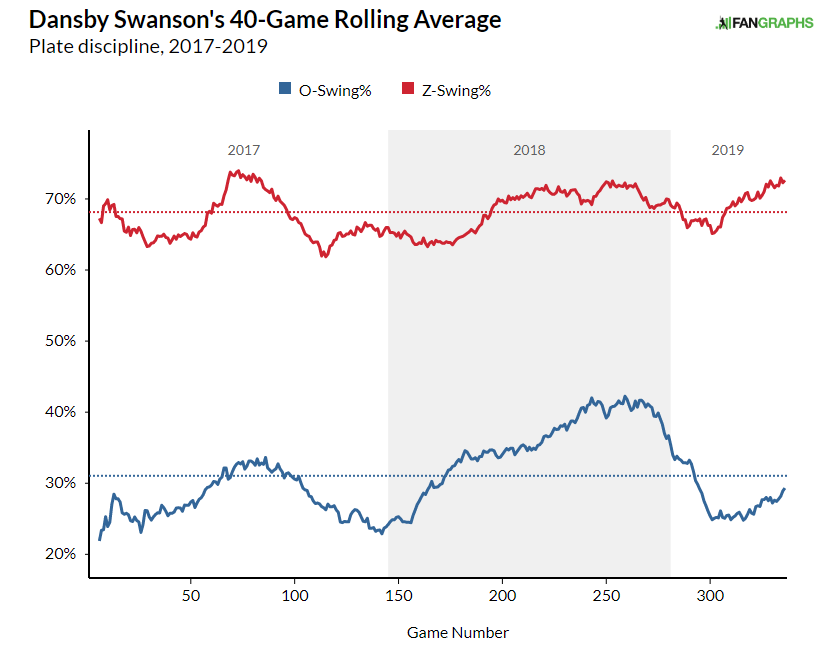



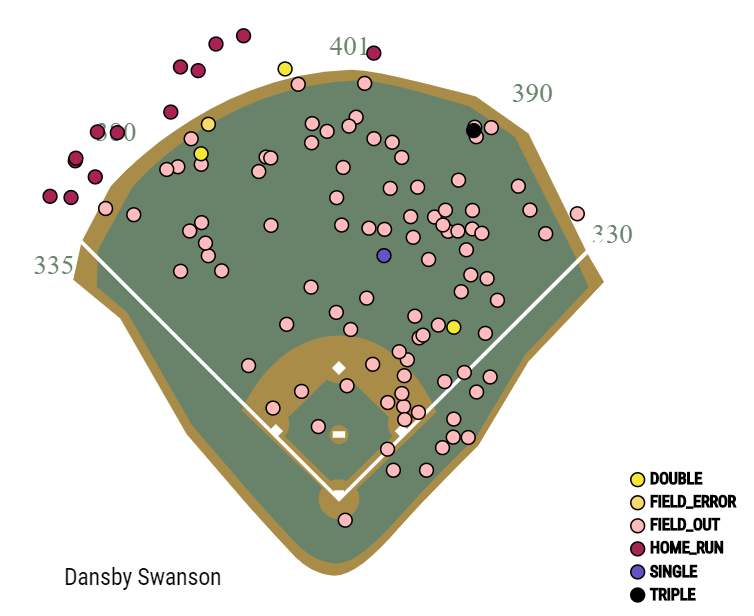
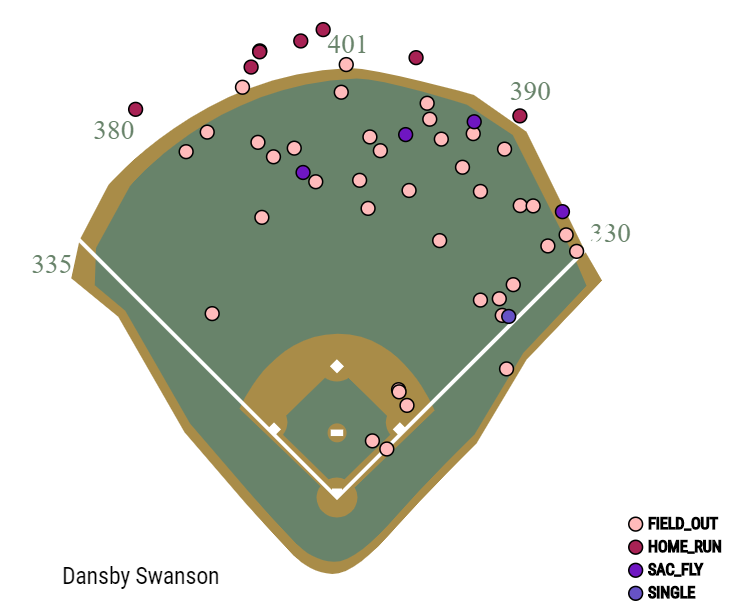
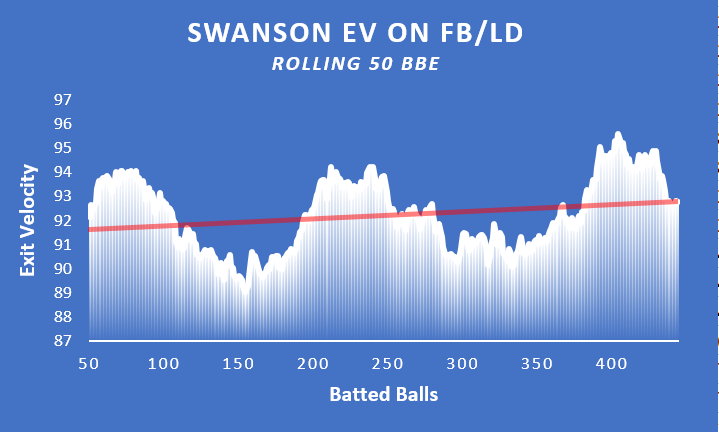
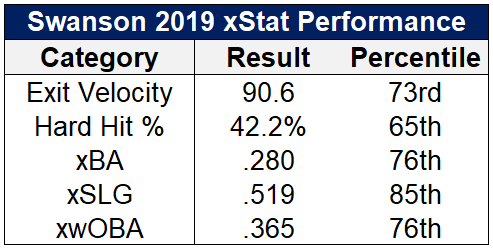

Thank you for doing a dive into his success this year!! He’s easily been one of my favorite pickups this season and it’s so exciting to see him improving as he has. Grabbed him right after my draft after seeing his potential in spring training.
I did a straight challenge trade for $8 Swanson at the start of the year in my dynasty league, giving up $22 Peraza. I think the guy I was getting him from thought he’d fleeced me with another Swanson April mirage. He’s since flipped Peraza again.
Interesting narrative notes: Swanson had surgery in the offseason to remove a piece of cartilage in his wrist that had bothered him all last year. And he worked with Chipper Jones on his swing.
Interesting that an entire article was written without mentioning that Dansby hurt his wrist right at the beginning of last year and basically played one handed all year in considerable pain. One other point and that the lineup became totally transformed when Austin Riley was called up. This allowed Acuna to move to leadoff and Dansby to 2nd.